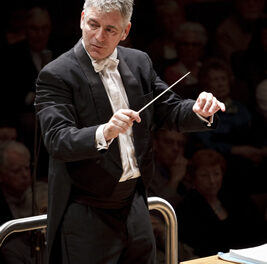The Young Artists Orchestra, an Eastern Music Festival student-only ensemble, was led by festival director Gerard Schwarz in an evening of great works and a lot of unplanned stage choreography. There was a noticeable difference between the inevitably sold-out concerts of the Saturday night Eastern Festival Orchestra faculty presentations and these almost half-empty student orchestral concerts, despite the presence of a world-renown soloist.
It’s debatable that Richard Strauss actually “invented” the tone poem, but music history invariably links him with this musical storytelling perhaps more than any other composer. In 1889, at the ripe old age of twenty-five, Strauss completed “Tod und Verklarung” (“Death and Transfiguration”), a musical depiction of a dying man reviewing his life and reaching for his longed-for transfiguration to the afterlife. This is typical Strauss: monstrously difficult parts combined with highly emotional and sometimes self-referential themes. Although written by a young man, it is unlikely that there are many in this orchestra (all of whom are under twenty) that can identify with the ideas behind the music – that is where an experienced conductor like Schwarz really shows his expertise. He was able to shape the phrasing and elicit passion and conviction from a talented group who otherwise might come armed with “just” a big cache of technique. Even with that said, there were some problems with the opening asymmetrical rhythms by the violas and it took a while for that to get on track. However, the sweep and grandeur of this remarkable work enveloped everyone and brought us to a higher plane in a way that only music can.
Beethoven’s Piano Concerto No. 4 was scheduled next: all musicians off the stage, move the chairs and stands back, roll out the eleven foot Steinway, move everything back in place. OK, done. We’re waiting. An announcement is made that they are looking for a missing part. (I’ve had that nightmare many times). Finally, a signal is made to the musicians who are told to leave the stage again, the piano is moved off, and Borodin’s Symphony No. 2 is summoned from the on deck circle.
Full time work as a chemist, in addition to much energy spent on composition of his mammoth opera Prince Igor, caused final completion of Alexander Borodin’s second symphony to take about six years. A series of interruptions in his capacity as a medical professional, plus (speaking of missing parts) his loss of the full score extended the premiere until 1879. Although some dismissed it as too earthy and barbaric, it has become one of his most beloved works. Unlike the Strauss piece, this is a very much in-your-face, extrovert’s work that is a perfect vehicle for the youthful energy of this orchestra. The forceful, all down-bow opening rhythms are a foreshadowing of Stravinsky’s Rite of Spring. The second movement is one of those blazingly fast, virtuosic scherzos, and the players tossed off the speeding bullets with no sweat. It was in the slower third movement where the weak link reared its head, especially in the opening passages where the harp/clarinet duo were having very public rhythmic and intonation disagreements. The celebratory last movement has more of the sound of an American western than anything Russian, and it brought this very confusing first half to an exciting completion.
For my second concert at EMF I was experiencing the unusual occurrence of the program ending with a piano concerto, this time Beethoven’s lyrical fourth. Soloist Joseph Kalichstein, founding member of the Kalichstein-Laredo-Robinson piano trio with a musical pedigree that fills pages, gave a performance that was as good as it gets. The concerto opens quietly with the soloist stating a lovely, introspective theme that undergoes the usual miraculous Beethovian permutations. Schwarz was masterful, yet unobtrusive, serving as liaison between Kalichstein’s poetic rubatos and the need to keep the orchestra attuned to the soloist’s musical prerogatives. Like many of Beethoven’s middle movements of his concertos, this one suspends time as a ravishing theme of amazing economy settles over the audience. The beautifully orchestrated pedal tone by the principal cellist as counterpoint to the introduction of the rondo theme of the final movement sets us off on a joyous conclusion. While listening and watching Kalichstein perform, one tries to identify and describe just what it is that makes it so vibrant and revealing. Finally, you give up and just let it wash over you – a refined performance that leaves no doubt that it would make even the crotchety composer smile.











